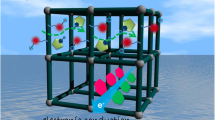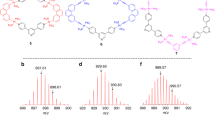Abstract
The reverse of the intercalation process involves oxidizing an intercalation compound to generate the host frame into which the ions were inserted. This frame was reduced during intercalation, and it is in turn oxidized by a more oxidizing agent that removes the mobile intercalated species (for example an alkali metal). Many reagents are sufficiently oxidizing to do this reaction, but it is necessary to use proper solventsto avoid hydrolysis for instance. Also, during the reaction Lix MXn → xLi++xe− +MXn, the oxidized and reduced forms of the reagent should be soluble in the non-reactive solvent.
Access this chapter
Tax calculation will be finalised at checkout
Purchases are for personal use only
Preview
Unable to display preview. Download preview PDF.
Similar content being viewed by others
References
D.W. Murphy, P.A. Christian: Science 205, 651 (1979).
D.W. Murphy, J.N. Carides, F.J. Di SaTd, C. Cros, J.V. Waszczak: Mat. Res. Bull. 12, 825 (1977).
D.W. Murphy, J.N. Carides: J. Elec. Soc. 126, 349 (1979).
R. Schöllhorn, A. Payer: Ang. Chem. Int. Ed. Eng. 24, 67 (1985).
S. Sinha, D.W. Murphy: Solid State Ionics 20, 81 (Tg86).
R. Brec, A. Dugast, A. Le Mehaute: Mat. Res. Bull. 15, 619 (1980).
R. Brec, G. Ouvrard, L. Blandeau: to be published.
A. Dugast, R. Brec, G. Ouvrard, J. Rouxel: Solid State Ionics 5, 375 (1981).
P. Gard, C. Sourisseau, G. Ouvrard, R. Brec: Solid State Ionics 20, 231 (1986).
K. Steudel: Ang. Chem. Int. Ed. Eng. 14, 655 (1975).
N. Elliott: J. Chem. Phys. 33, 903 (1960).
E. Anastassakis, C.H. Perry: J. Chem. Phys. 64, 3604 (1976).
H.D. Lutz, G. Kliche, H. Haenseler: Z. Nat. 36a, 184 (1981).
L. Blandeau, G. Fatseas, G. Ouvrard and R. Brec, J. of Solid State Chem., to be published 1986.
G.A. Fatseas, J.B. Goodenough: J. Solid State Chem. 41, 1 (1982).
Author information
Authors and Affiliations
Editor information
Editors and Affiliations
Rights and permissions
Copyright information
© 1986 Springer Science+Business Media New York
About this chapter
Cite this chapter
Brec, R. (1986). Recent Developments in New Host Structures. In: Dresselhaus, M.S. (eds) Intercalation in Layered Materials. NATO ASI Series, vol 148. Springer, Boston, MA. https://doi.org/10.1007/978-1-4757-5556-5_5
Download citation
DOI: https://doi.org/10.1007/978-1-4757-5556-5_5
Publisher Name: Springer, Boston, MA
Print ISBN: 978-1-4757-5558-9
Online ISBN: 978-1-4757-5556-5
eBook Packages: Springer Book Archive




